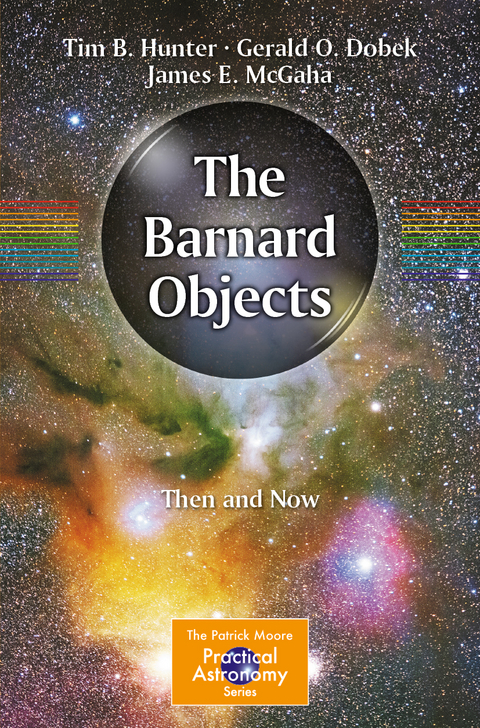
The Barnard Objects: Then and Now
Springer International Publishing (Verlag)
978-3-031-31484-1 (ISBN)
The Barnard Objects have fascinated professional and amateur astronomers for over one hundred years. Many of those objects first imaged by E.E. Barnard on black-and-white photographic plates are now being captured daily in thousands of color astrophotographs. This book tells of Barnard's story; describing his life and work as well as how the fields of astronomy and astrophotography have transformed ever since.
The chapters in this book are equal parts history and science. It will provide readers with an introduction to nebula science and the incredible discoveries made in this field over the decades; including an overview of popular astronomical catalogues and a detailed look at how astronomical imaging has advanced since Barnard's time, from early plates to digital imaging and chips. In addition, the book features a comprehensive guide to viewing and imaging these objects yourself. A glossary of astronomical and photographic terms is provided, along with detailed references.And, an updated table displaying the locations of these Barnard Objects; including the missing twenty-five objects from E.E. Barnard's original catalogue.
Richly researched and illustrated, this fascinating reference will attract astronomers of all skill levels interested in astrophotography and how it has changed over the past hundred years.
Dr. Tim Hunter is Professor Emeritus in the Department of Medical Imaging in the College of Medicine at the University of Arizona and was Head of the department 2008-2011. He has been an amateur astronomer since 1950 and owns the 3towers Observatory and the Grasslands Observatory. Dr. Hunter has been the President of the Tucson Amateur Astronomy Association, Inc. (TAAA) and a member of the TAAA since 1975. He was previously Chair of the Board of Trustees of the Planetary Science Institute (PSI). Since 1986, Dr. Hunter has been interested in the growing problem of light pollution. In 1987, he and Dr. David Crawford founded the International Dark-Sky Association, Inc. (IDA). IDA is a nonprofit corporation devoted to promoting quality outdoor lighting and combatting the effects of light pollution. Since 2007, Dr. Hunter has written a weekly “Sky Spy” column for the Caliente Section of the Arizona Daily Star. Asteroid 6398 is named Timhunter. James E. McGaha obtained a BS in management and physics from Georgia Tech University, an MA in management and psychology from Webster University, and a MS in Astronomy and Astrophysics from the University of Arizona. He is currently a retired United States Air Force pilot and is a skeptic lecturer. He is the Director of the Grasslands Observatory (www.3towers.com) and specializes in asteroid and comet astrometry and photometry. He has made over 2900 Minor Planet Electronic Circular (MPEC) publications of near-Earth objects (NEOs) and discovered 63 comets. He identified and performed photometry of optical afterglow of gamma ray burst 030329. He is a contributing author for Skeptical Inquirer magazine and is a scientific and technical consultant to the Committee for Skeptical Inquiry (CSI). He is a Fellow of the Royal Astronomical Society (RASC). Prof. Gerald Orin Dobek obtained two BS degrees in Mathematics, Trinity College and Ferris State University, a MSc Honours in Astronomy from the University of Western Sydney and a DSc in Astronomy and Astrophysics from James Cook University. Dr. Dobek is currently the Head of Sciences and Department Head of Astronomy at Northwestern Michigan College, where he teaches Astronomy. As a professional astronomer, he researches small amplitude variable stars using his private observatory at his home in Traverse City, Michigan. Jerry also continues to research dark nebulous material in the Milky Way. In 2011, he republished Edward Emerson Barnard’s “A Photographic Atlas of Selected Regions of the Milky Way,” adding updated information and a mosaic of the fifty plates contained within the Atlas. Jerry holds membership in numerous astronomy and science organizations: FRAS, AAS, AAAS, AAVSO, ASP and is a founding member of the IDA.
Chapter 1. Introduction.- Chapter 2. Nebulae: an overview.- Chapter 3. Astronomical Catalogs: an overview.- Chapter 4. Barnard and his photography.- Chapter 5. Visual Observation of the Barnard Objects.- Chapter 6. Modern Imaging of the Barnard Objects.- Chapter 7. Selected Barnard Objects.- Chapter 8. The Missing Barnard Objects.- Chapter 9. The Barnard Objects Now.
"I can thoroughly recommend this book. It clearly is the product of a huge amount of research and observational effort. It is written with authority and has a flowing style, and crammed with the fascinating detail that only such practical specialists in this field can provide." (Richard McKim, The Observatory, Vol. 144 (1300), June, 2024)
| Erscheinungsdatum | 21.07.2023 |
|---|---|
| Reihe/Serie | The Patrick Moore Practical Astronomy Series |
| Zusatzinfo | XL, 343 p. 108 illus., 91 illus. in color. |
| Verlagsort | Cham |
| Sprache | englisch |
| Maße | 155 x 235 mm |
| Gewicht | 649 g |
| Themenwelt | Naturwissenschaften ► Physik / Astronomie ► Astronomie / Astrophysik |
| Schlagworte | astronomical catalog history • astronomy catalog overview • Barnard Object astrophotography • Barnard Objects in color • biography E.E. Barnard • E.E. Barnard • history of nebulae research • imaging Barnard Objects • life of E.E. Barnard • observing Barnard Objects • portrait lens astrophotography • Types of nebulae |
| ISBN-10 | 3-031-31484-0 / 3031314840 |
| ISBN-13 | 978-3-031-31484-1 / 9783031314841 |
| Zustand | Neuware |
| Haben Sie eine Frage zum Produkt? |
aus dem Bereich


